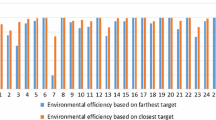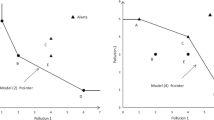Abstract
Air pollution continues to pose a major threat to human health in China and its neighbor countries including Japan. Although the general clean air trend in China is to replace older coal-fired generation with clean energy, \(60\%\) coal consumption in the overall energy use still makes it the most coal-dependent country. Improvement of the coal-fired generation efficiency is fully expected to play a vital role for the foreseeable future. Focusing on the main air pollutants, this paper presents a comprehensive study from the target region selection in China to the benefit allocation analysis for a potential collaboration between China and Japan in Integrated coal Gasification Combined Cycle (IGCC). Both radial and non-radial two-stage data envelopment analysis models with undesirable intermediate measures are applied first to evaluate the regional air quality improvement efficiencies in China (2005–2014). Due to the extremely high initial and dynamic investment for IGCC, target regions with the highest priorities to be installed with this technology are selected by k-means clustering method based on the results of two-stage data transformation model under variable returns to scale. Finally, a benefit analysis by multi-criteria allocation game with the principal performance indices from two representative IGCC power plants in China and Japan provides further insights for the mutual motivations of this kind of collaboration and uncovers some international policy implications.



Similar content being viewed by others
References
Amirteimoori A (2013) A DEA two-stage decision processes with shared resources. Cent Eur J Oper Res 21(1):141–151
Bi GB, Song W, Zhou P, Liang L (2014) Does environmental regulation affect energy efficiency in China’s thermal power generation? Empirical evidence from a slacks-based DEA model. Energy Policy 66:537–546
Charnes A, Cooper WW, Rhodes E (1978) Measuring the efficiency of decision making units. Eur J Oper Res 2(6):429–444
Chen Y, Liang L, Zhu J (2009) Equivalence in two-stage DEA approaches. Eur J Oper Res 193(2):600–604
CNBS (2016) China statistical yearbook. National Bureau of Statistics of China, Xicheng
Cook WD, Liang L, Zhu J (2010) Measuring performance of two-stage network structures by DEA: a review and future perspective. Omega 38(6):423–430
Cooper WW, Park KS, Pastor JT (1999) RAM: a range adjusted measure of inefficiency for use with additive models, and relations to other models and measures in DEA. J Prod Anal 11(1):5–42
Färe R, Grosskopf S (2004) Modeling undesirable factors in efficiency evaluation: comment. Eur J Oper Res 157(1):242–245
Färe R, Grosskopf S (2006) New directions: efficiency and productivity, vol 3. Springer, Berlin
Hatami-Marbini A, Saati S, Sajadi SM (2018) Efficiency analysis in two-stage structures using fuzzy data envelopment analysis. Cent Eur J Oper Res. https://doi.org/10.1007/s10100-018-0545-8
Ishibashi Y (2017) Coal fired high efficiency power generating technology “IGCC” No. 10 unit in Nakoso power station of Joban Joint Power Company. Proc Gas Turbine Soc Jpn 45(3):128–133
Jablonsky J (2018) Ranking of countries in sporting events using two-stage data envelopment analysis models: a case of Summer Olympic Games 2016. Cent Eur J Oper Res. https://doi.org/10.1007/s10100-018-0537-8
Kao C (2014) Efficiency decomposition in network data envelopment analysis with slack-based measures. Omega 45:1–6
Lazard (2017) Levelized cost of energy analysis, version 11.0
Liang D, Xing X, Shen W (2013) Technical and economic evaluation of China’s integrated gasification combined cycle: the case of Yantai project. Low Carbon Econ 4(3):117
Liang L, Cook WD, Zhu J (2008) DEA models for two-stage processes: game approach and efficiency decomposition. Nav Rese Logist (NRL) 55(7):643–653
Liu W, Zhou Z, Ma C, Liu D, Shen W (2015) Two-stage DEA models with undesirable input-intermediate-outputs. Omega 56:74–87
Lovell CK, Pastor JT, Turner JA (1995) Measuring macroeconomic performance in the OECD: a comparison of European and Non-European countries. Eur J Oper Res 87(3):507–518
NETL (2016) Gasification plant databases. National Energy Technology Laboratory, Albany
Scheel H (2001) Undesirable outputs in efficiency valuations. Eur J Oper Res 132(2):400–410
Seiford LM, Zhu J (2002) Modeling undesirable factors in efficiency evaluation. Eur J Oper Res 142(1):16–20
Sekine S, Fu J, Muto S (2014) Game theoretic approaches to weight assignments in data envelopment analysis problems. Math Prob Eng 2014:9
Shepherd RW (1970) Theory of cost and production functions. Princeton University Press, Princeton
Song W, Bi Gb WuJ, Yang F (2017) What are the effects of different tax policies on China’s coal-fired power generation industry? An empirical research from a network slacks-based measure perspective. J Clean Prod 142:2816–2827
Sueyoshi T, Goto M (2012) Returns to scale and damages to scale under natural and managerial disposability: strategy, efficiency and competitiveness of petroleum firms. Energy Econ 34(3):645–662
Tone K (2001) A slacks-based measure of efficiency in data envelopment analysis. Eur J Oper Res 130(3):498–509
Tone K, Tsutsui M (2009) Network DEA: a slacks-based measure approach. Eur J Oper Res 197(1):243–252
Von Neumann J, Morgenstern O (1944) Theory of games and economic behavior. Princeton University Press, Princeton
Wang K, Lu B, Wei YM (2013) China’s regional energy and environmental efficiency: a range-adjusted measure based analysis. Appl Energy 112:1403–1415
Wang LJ, Wu Q, Yang D, Jin-Xuan S (2016) The development and practice of IGCC in China. In: The 21st conference of the electric power supply industry
Zhang Q, Jiang X, Tong D, Davis SJ, Zhao H, Geng G, Feng T, Zheng B, Lu Z, Streets DG et al (2017) Transboundary health impacts of transported global air pollution and international trade. Nature 543(7647):705–709
Zheng JR (2016) Smog spreads out as readings spike. China Daily, Beijing
Zhou P, Poh KL, Ang BW (2007) A non-radial DEA approach to measuring environmental performance. Eur J Oper Res 178(1):1–9
Zhou Y, Xing X, Fang K, Liang D, Xu C (2013) Environmental efficiency analysis of power industry in China based on an entropy SBM model. Energy Policy 57:68–75
Author information
Authors and Affiliations
Corresponding author
Additional information
This research has been financially supported by The Science Research Promotion Fund 2016-No. 41.
Rights and permissions
About this article
Cite this article
Fu, J. Two-stage data envelopment analysis with undesirable intermediate measures: an application to air quality improvement in China. Cent Eur J Oper Res 26, 861–885 (2018). https://doi.org/10.1007/s10100-018-0564-5
Published:
Issue Date:
DOI: https://doi.org/10.1007/s10100-018-0564-5
Keywords
- Two-stage DEA
- Undesirable intermediate measures
- Data Transformation
- Multi-criteria allocation game
- Air quality improvement
- IGCC




